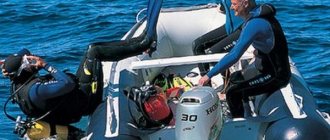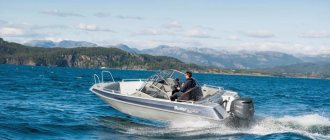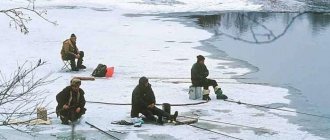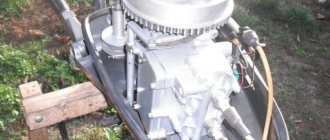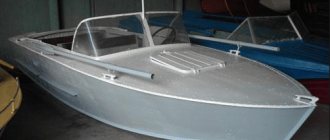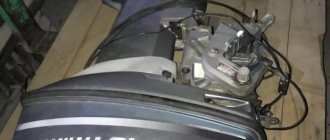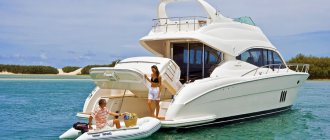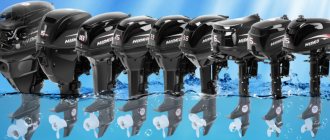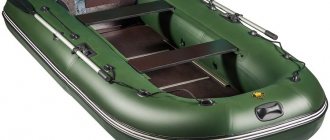Perhaps every fisherman and even just a lover of water recreation sooner or later thinks about buying an inflatable boat. After all, with your own watercraft you can get to a secluded and, of course, fishy backwater on the other side, and see what is there downstream or upstream, and get a lot of new impressions. However, you won’t get far with an oar drive, so you should immediately consider purchasing a motor for a PVC boat. After all, many of the latter today already have everything necessary for mounting the engine in their basic design. Moreover, in the offered range of power plants you can also find an option for a boat that does not have a transom. The range of technical characteristics and prices is also very wide - there is a suitable option for any task and for any budget.
Fishing life vest Camo EXTREAL 1,820 for 1 piece. Safety vest Suzun (double-sided) Helios 1,710 for 1 piece. Aleksandrov rescue line 15m 510 per 1 piece. Safety vest (ZhS-03) AQUATIC 1,999 for 1 piece. Tench Floating flat 14.0 mm, 900 kg, 25 m, euro coil 25 per 1 m. Safety vest (with collar) (ZhS-01X) AQUATIC 3,761 per 1 piece. Safety vest “Raft” with headrest, weight up to 80 kg White stone 1,535 for 1 piece. Safety vest “Raft” (Medium) White stone 1,350 per 1 piece.
However, such a wide choice also plays a negative role. It may be difficult for an unprepared buyer to decide which outboard motor is best to choose specifically for his goals and objectives. And making the wrong choice can literally become costly. Therefore, before opening the engine catalog, you need to study the hardware and understand the key aspects of choosing by type and power. The experts of the Trophy online store are ready to help you with this.
Get specific with your goals
Before you begin to specifically select a motor model, you need to decide for what purposes you need it. It is the nature of the upcoming tasks that will determine the optimal power and almost all other technical parameters, as well as, of course, the price of the unit.
Let's consider a practical situation:
- the motor is selected for fishing;
- There are no plans for long-distance voyages in search of fishing spots;
- a calm body of water - a river with a slow current or even a lake.
In such conditions, power and performance will not be so critical; it is better to focus on the lightness of the engine and fuel efficiency. In addition, a budget class engine is quite suitable for the above tasks.
Boat Altai 320L with Tonar motor 42 120 for 1 piece. Boat Altai A340 with Tonar motor 51,030 for 1 piece. PVC boat Compact Riviera 3200 SK camouflage reed Riviera 38,970 for 1 piece. Boat Captain A320 (inflatable bottom) green Tonar 39,680 for 1 piece. Boat Altai 400A (gray, inflatable bottom) Tonar 67,020 for 1 pc. PVC boat AQUA 3200 SKK (slang-book, keel) Aqua 27,230 for 1 piece. PVC boat AQUA 3200 NDND Aqua 33,410 for 1 piece. Boat Skipper A260nt (hinged transom, inflatable bottom) (green) Tonar 17,805 for 1 piece. PVC boat AQUA 2800 for Aqua motor 16,520 for 1 piece.
Now another situation close to reality:
- the owner of the boat wants to develop the highest possible speed on it;
- the boat is large, roomy and heavy, most likely with a rigid folding bottom.
For such conditions, high motor power is important, as well as its reliability - it must withstand long-term overloads. In this case, you need to be prepared to pay a hefty sum for the motor; in addition, it will be quite bulky and heavy.
Of course, the examples given are close to extremes, but at the same time they objectively characterize the needs of many buyers. Therefore, now let’s talk about the important parameters separately.
Types of boat motors
The traditional option is a gasoline engine. This is an option proven by long-term operation, unpretentious and productive. It runs on regular gasoline and allows you to develop a decent speed on water. The main advantage of gasoline traction is autonomy. The fuel consumption of a small internal combustion engine is modest, so it is enough to take a can of gasoline with you, and the likelihood of being left motionless on the water is minimized.
However, gasoline models also have significant disadvantages:
- they are relatively heavy and bulky;
- their work is associated with high noise levels;
- The design of the internal combustion engine requires periodic maintenance.
In addition, you need to take into account that gasoline boat engines are divided into two- and four-stroke models. The former are cheaper and lighter; their design often includes a built-in gas tank. At the same time, they are less convenient, since they need to be refueled not with gasoline, but with a gasoline-oil mixture with precise proportions of fuel and lubricant. Two-stroke engines are also noisier and less economical.
Four-stroke engines have a longer service life, the fuel they fill is clean, they operate quieter and consume less gasoline. These advantages are offset by the increased complexity of repairs, heaviness and high cost.
In general, 2-stroke motors make up the bulk of all supply and demand for outboard motors. They are easier to transport and maintain. The main advantage is a significantly lower price. 4-stroke engines are preferred by professional fishermen, who value such engines for their combination of performance, less noise and stable traction at rpm. Therefore, if you specialize in trolling fishing, then a 4-stroke internal combustion engine will be preferable for you.
Boat electric motor T18-FW 12v/15A 2speed/2rev. 600mm series Asp/T BADGER Watersnake 7 515 for 1 piece. Boat electric motor HDX 32L HDX 12,900 for 1 piece. Boat electric motor MINN KOTA Ulterra112 IP/152cm/36v MINN KOTA 322 320 for 1 pc. Boat electric motor COMBAT CRC 54/48 BADGER (55311) Watersnake 44,992 for 1 piece. Boat electric motor MINN KOTA Endura MAX 40 MINN KOTA 36 780 for 1 piece.
Electric motors stand apart. They are attractive primarily for their availability, noiselessness, low weight and minimal maintenance requirements. With such a motor you can safely raft even in specially protected water areas - they are absolutely harmless to nature. The main disadvantage of electric traction is that such engines are powered by batteries. And they are usually heavy and expensive. In addition, the battery can only be recharged from the mains - so you won’t be able to sail far with an electric drive.
Electric motors
One popular solution for propelling a boat is an electric motor. This solution is more popular in Europe, but we are also increasingly resorting to this option.
The main advantage over gasoline types is quiet operation and high environmental friendliness.
Also, the engines have a low price, which is incomparable with internal combustion engines.
But in addition to the engine, you also need to purchase a high-quality battery and charger.
In total, the result is an option that is not much cheaper than a gasoline engine. In normal operation, electric boat motors are very simple.
How to choose a charger for such a motor is usually written in the instructions. The main parameter for it is the amount of current that it can provide.
There are also disadvantages to this type of engine. When charging the battery, there is no way to know exactly how long it will last when constantly moving. You will also have to constantly charge it for several hours before going out. Such procedures can cause significant inconvenience to planned trips on a boat with an electric motor.
How to calculate engine power
To determine the appropriate amount of horsepower, first of all, pay attention to the boat’s registration certificate. In the vast majority of cases, it will indicate the maximum permissible power of the power unit for which the design of the watercraft is designed.
Now let's return to the situations we considered above. For hunting and fishing in a relatively small water area, a speed of 6-12 km/h will be sufficient, provided that your already equipped watercraft weighs no more than 120 kilograms. A 2.5-4 hp two-stroke engine can easily cope with this task; its potential will be sufficient in these conditions. And if you have a boat with an inflatable bottom (INB) or a so-called punt, then even with a relatively weak two-stroke the boat can reach planing.
If you need high speeds, then the power must be appropriate - at least 5-6, and preferably 8-10 hp. You also need to take into account that the intensity of acceleration and the ability to enter planing mode will largely depend on how the load is located in the boat. If you overload the bow, it will constantly bury itself in the waves. However, there is no point in dragging all the luggage back - the stern is already weighed down by the motor. The best option is to distribute the load evenly in the boat. This will not only make it easier to gain speed and get on glide, but will also increase traffic safety.
To determine the exact planing power that suits you, use the following formula:
- the total load is determined - this is the total weight of the boat, engine, passengers and all belongings;
- divide the result by 30;
- round the value to 0.1;
- the resulting value will be the required power.
Let's look at an example. The weight of a 320 cm boat with all the equipment is approximately 35 kg. The motor weighs around 25 kg. Crew weight 160 kg. Gas tank and luggage – another 30 kg. Total, the boat's own weight with the engine is 60 kg, the load is 190 kg - we get 250 kg of total load. Divide by 30, round up - and we get 8.3 hp.
However, this is a minimum value; it is better to pay attention to models of outboard motors with a performance reserve. Therefore, in order to be able to go with the whole family on a long river voyage, it is better to choose a 9.8-9.9 hp engine. However, immediately keep in mind that the more powerful the power plant, the more expensive, larger and heavier it is. That is, immediately provide for storage space and transportation options.
Features of choice
If you need an engine that will provide long trips, then, of course, you need to choose the gasoline option, as it can guarantee greater reliability. If there is an option to use electric boat motors, how to choose will help the purpose of the boat. If it will be used to quietly approach fishing spots, then this option will be more suitable, as it has silent operation.
In the case of gasoline engines, you need to pay attention to the characteristics of the boat on which the installation will take place.
You should also choose what is more important: lower fuel consumption or longer engine life?
Experts recommend installing two-stroke engines on small boats and boats for one person.
In the case of a large boat and several people, four-stroke engines are more suitable. But these recommendations are not critical and in both cases different types of engines can be used.
Choosing the optimal deadwood
This term refers to the length of the “leg” of the motor, which is lowered into the water and ends with the propeller. Deadwood length is in most cases standardized into 3 classes:
- short – 381 mm, the most common option for 2-stroke engines with low power;
- long – 508 mm, widely used on engines with power from 10 hp;
- extra-long – 635 mm, these are 4-stroke engines from 175 hp.
However, individual producers may have their own subcategories of deadwood. For example, YAMAHA offers exclusive engines with an ultra-long 762 mm deadwood.
A PVC boat with a rigid transom requires individual calculations. Determine the distance from the top of the transom to the bottom. Based on the obtained value, select the appropriate length of the “motor leg”. The deadwood of a motor is measured from the top mounting point to the bottom plane of the anti-cavitation plate.
Most motor boats are standardized to a specific sternwood. There may be minor deviations of a few centimeters, but they are not critical. This unification makes it easier to select both a motor for the transom height and a boat for the motor.
A “leg” that is too long will lead to increased resistance, which will make it more difficult for the motor to reach the required speed, its resource will be consumed faster, and the gluttony of the motor will increase, as will the risk of damage to its lower part.
Top 10 outboard motors 9.9 hp.
Outboard motor HDX T 9.9 BMS
The Chinese-made HDX T 9.9 BMS two-stroke, 246cc, two-cylinder outboard motor boasts a 24-litre external fuel tank, weighs 36kg, is manually started and has tiller control. The engine is designed for manual installation on a boat transom, 381 mm high. To select the direction of movement, there are gears: Forward-Neutral-Reverse (FNR), shallow water mode. This boat motor is 9.9 hp. consumes fuel 7.5 liters per hour, cooled by a liquid system.
Outboard motor Hidea HD 9.9 FHS
The Chinese-made two-stroke outboard motor Hidea HD 9.9 FHS with a pair of cylinders, a displacement of 326 cm³, is equipped with a 24-liter fuel tank, manual start and control using a tiller. The engine is designed for manual installation on a boat transom, 381 mm high. To select the direction of movement, there are gears: Forward-Neutral-Reverse (FNR), shallow water mode. This boat motor is 9.9 hp. weighs 41 kg, cooled by a liquid system.
Outboard motor Mercury 9.9 M 169cc
The American-Japanese-made Mercury 9.9 M two-stroke outboard motor with two cylinders, a displacement of 169 cm³, has a 12-liter fuel tank and weighs 26 kg. The compact engine is started by hand pulling the starter cord, controlled by a tiller, and equipped with a liquid cooling system. This boat motor is 9.9 hp. has a choice of movement direction: Forward-Neutral-Reverse (FNR), shallow water mode.
Outboard motor Mikatsu (Mikatsu) MF 9.9 FS
The four-stroke, two-cylinder, outboard outboard motor Mikatsu (Mikatsu) MF 9.9 FS, made in China, is distinguished by the presence of a 12-liter fuel tank. The engine is started manually with a starter cord, controlled manually with a tiller, and has a displacement of 212 cm³. Outboard motor 9.9 hp consumes 3.3 liters per hour, is cooled by running water and has a choice of movement direction: Forward-Neutral-Reverse (FNR), shallow water mode. The engine weighs 41 kg.
Outboard motor Mercury 9.9 M 247cc
The American-Japanese-made Mercury ME 9.9 M two-stroke outboard motor with two cylinders, a displacement of 247 cm³, has a 25-liter fuel tank and weighs 41 kg. The compact engine is started by hand pulling the starter cord, controlled by a tiller, and equipped with a liquid cooling system. This boat motor is 9.9 hp. has a choice of movement direction: Forward-Neutral-Reverse (FNR), shallow water mode.
Outboard motor SEA-PRO (Sia-Pro) OTN 9.9S
The two-stroke, outboard outboard motor SEA-PRO (Sia-Pro) OTN 9.9S, made in China, is an exact copy of the Yamaha. The two-cylinder engine with a displacement of 246 cm³ is equipped with a 24-liter fuel tank, manual start and control using a tiller. The engine is designed for manual installation on a boat transom, 381 mm high. To select the direction of movement, there are gears: Forward-Neutral-Reverse (FNR), shallow water mode. This boat motor is 9.9 hp. weighs 36 kg, cooled by a liquid system.
Outboard motor GLADIATOR (Gladiator) 9.9 FHS
The Chinese-made GLADIATOR 9.9 FHS two-stroke outboard motor with two cylinders and a displacement of 247 cm³ boasts an external fuel tank of 24 liters, weighs 37.5 kg, is manually started and controlled by a tiller. The engine is designed for manual installation on a boat transom, 381 mm high. To select the direction of movement, there are gears: Forward-Neutral-Reverse (FNR), shallow water mode. This boat motor is 9.9 hp. consumes fuel 7.3 liters per hour, cooled by a liquid system.
Outboard motor Yamaha 9.9FMHS/GMHS
The Yamaha 9.9FMHS/GMHS two-stroke outboard motor of the famous Japanese brand is equipped with two cylinders, a displacement of 246 cm³, manual start and tiller control. The kit includes a fuel tank with a capacity of 24 liters. This boat motor is 9.9 hp. designed for installation on a transom, dimensions S 442 mm. The engine weighs 36 kg, is cooled by a liquid system, and consumes 5.1 liters per hour.
Outboard motor HANGKAI (Hankai) M9.9HP
The Chinese-made two-stroke gasoline outboard engine HANGKAI (Hankai) M9.9HP has a displacement of 246 cm³, two cylinders, manual start and control. Among the equipment, we note the presence of a 24-liter fuel tank. This boat motor is 9.9 hp. designed for installation on a transom, dimensions S 440 mm. The engine weighs 36.5 kg and is cooled by a liquid system.
Outboard motor Mikatsu (Mikatsu) M9.9FS
The Chinese-made outboard, two-stroke, two-cylinder outboard motor Mikatsu M9.9FS with a displacement of 246 cm³ is started by manual pull of the starter cord, has a tiller control and is designed for installation on a boat transom, with dimensions S 381 mm. The kit comes with a 24 liter fuel tank. There is a driving direction option: Neutral-Reverse (FNR), shallow mode. The engine weighs 36 kg and is cooled by a liquid system.
Types of start-up and control systems
Boat motors can start in different ways:
- A cable starter is a classic solution. To start the engine, you need to sharply pull the cable. Not very convenient, but budget-friendly.
- An electric starter is an attribute of expensive modern engines. Starting is carried out by pressing a button or turning the key. More convenient, but significantly more expensive.
The control system can also be traditional or more advanced. The first option is a tiller extending directly from the engine. It sets both the direction of movement and speed. The manager has to constantly be near the engine. The second option is a steering system or remote control. More convenient, but also more expensive.
Engine management system
When installing any motor on a boat, the control system is of great importance. It can be a tiller, that is, it is controlled directly by the handle of the engine itself. There are also options for remote control using a transmission mechanism. Each of them has certain features that allow you to control the boat in different situations.
Remote control is more suitable for long boats with a rudder installed in the middle part. In simple small boats, the rear steering type is predominantly used. It is worth noting that the tiller system is more reliable, since it has fewer interaction mechanisms. Therefore, before choosing a boat motor, you need to decide on its control type and choose the one more suitable for a particular boat.
Popular manufacturers of motors for PVC boats
The most popular brands in Russia are American, Chinese, Korean and Japanese:
- YAMAHA is one of the pillars of the boating industry;
- Suzuki is another famous manufacturer from Japan;
- Tohatsu – again Japan, high quality and wide range of models;
- Mikatsu is a division of the Korean concern Hyundai, high-quality, powerful and relatively inexpensive engines;
- MERCURY are leading engine manufacturers from the USA with production in Japan.
- Johnson is another famous brand from the USA;
- Hidea is a promising manufacturer from China;
- HDX are Chinese motors that combine good quality and sufficient reliability.
On the issue of registration
According to current regulations, for the use of a boat with a motor with a power of 10 hp or more. license and registration with GIMS (State Inspectorate for Small Vessels) is required. This means that you will have to regularly undergo technical inspection and pay transport tax. The rate of the latter can be calculated based on the standards published annually by the Tax Service.
Folding boat anchor YALS-01 Tonar 940 for 1 pc. Anchor YAL-08 (4 kg) Tonar 2,705 per 1 piece. Anchor YAL-04 Tonar 1,820 for 1 piece. Cat anchor YALS-02 (2.5 kg) Tonar 1,365 for 1 piece. Folding anchor 6kg (SM301060) 3,695 for 1 piece. Folding anchor 8kg (SM301080) 4,800 per 1 piece. Hall anchor 6 kg 303060 3,707 per 1 piece. River anchor 18 lb. (ACHR-RIVER BLK PVC 18#) 9946B1 4,255 for 1 piece.
During registration, GIMS inspectors will definitely check that the engine power matches the technical parameters of the boat. If the engine turns out to be much more powerful than permissible, a refusal will be issued. Therefore, take into account the rule “lighter boat - weaker engine” and take into account the recommendations of the manufacturer of your watercraft.
Choosing an outboard motor, purchasing an outboard motor
Fishing industry
MOTORS, BOATS... (Russian) LAW, PRACTICE... Buying the first boat (outboard) motor is a very important step in the life of any fisherman. As a rule, this is preceded by numerous consultations with colleagues on the Internet, studying literature, going to specialized stores and: coordinating the family budget. When all the stages have already been completed, it would seem a simple matter to go and buy, but not everything is so simple. There are several “pitfalls” that a happy motor owner will have to “face” from the very first steps of operating his “outboard assistant”. Is a beginner boater ready for this mentally, physically and financially? So, everything in order:
- Even before purchasing a motor, it is necessary to decide on the reservoirs on which it is planned to be used. In accordance with the Sport Fishing Rules existing in each region, there may be water areas where the operation of internal combustion engines is prohibited. Are your chosen ones among them?
- An outboard boat motor, as such, is not subject to registration with the GIMS. It fits into the ship's ticket, issued as a registration document for the watercraft. This means that when operating a motor without your own personal boat, you need to carry with you the documents issued upon its purchase (cash and sales receipts as evidence of its legal purchase).
- When you start the engine suspended on the transom of the boat and grab the tiller, you become the person driving the vehicle. The legislator does not distinguish between an internal combustion engine and an electric boat motor. You must have a license of the established form issued by GIMS.
To obtain this document, as a rule, it is necessary to complete navigator courses (in some regions it is possible to take it externally, but subject to previously graduating from nautical, naval or shipbuilding educational institutions, where the relevant courses were taught and passed as part of the training program).
If you, having successfully passed the exam, upon completion of the courses (or as an external student) received the RIGHTS to operate one of the watercraft: aquabike (jet ski); a sailing vessel with a sail of up to 12 square meters; a motorboat with an outboard motor without power limitation; boat with a stationary engine with a power of up to 75 horsepower - in the MP and GDP areas permitted for navigation, then you already know everything that is stated below.
For those who are just preparing for the courses, some aspects will be new.
Let's assume that you decide to go fishing by renting a boat:
IN THIS CASE PAY ATTENTION: what is the maximum permissible power for which this housing is designed; what is the condition of the hull and transom of the boat, especially in the places where the transom is adjacent to the sides and bottom; does the transom height of the selected boat correspond to the installation parameters of your motor; Are there safety blocks?
The following should be especially noted. Exceeding the maximum permissible power is fraught with serious consequences, both from the standpoint of your own safety and from the standpoint of law enforcement agencies monitoring water safety.
The permit issued by the ranger at the base must indicate that the rowing boat, and this is how boats like “Pella”, “Pella-Fiorda”, “Mullet”, “Laguna”, etc. are registered, is used as a motor boat. with a motor like this. When using a motor vessel based on the hull, such as the Kazanka or Progress, the paperwork is the same.
If you take a watercraft from a private person, for example, from your friend who lives on the shore, then pay attention to the following points: the hull must bear the side number; the shipowner must have a ship's ticket with marks of completion of the annual technical inspection; the shipowner must issue a power of attorney for the right to steer in the name of the helmsman for the appropriate period.
The power of attorney is issued by hand indicating the passport details of the shipowner and helmsman. And, naturally, you should have documents for a motor and a boat driver’s license with you on the water.
Note: the law requires a notarized power of attorney for a watercraft only when resolving financial issues on behalf of the shipowner. Any violation of the law, the absence of the above documents is fraught with severely spoiled fishing. According to the law, this can be a punishment ranging from a verbal reprimand and transfer of the boat to rowing mode, to the removal of the boat and its placement in an impound lot (with all the consequences).
After riding on rental boats, many begin to think about switching to SHIP OWNERSHIP mode.
A few words on possible options for boats up to 5 meters in length. But first you need to realistically assess your financial capabilities and decide on the reservoir(s).
So, to choose from: Inflatable boat (rubber or PVC); Rigid hull (metal or plastic, open or cabin, planing or displacement, domestic or imported, and finally, new or used); RIB (plastic or metal, hard case).
INFLATABLES
LET'S LIST THE ADVANTAGES. The most compact (both in transportation and in operation), lightweight and mobile craft. Allows you to “reach” almost any body of water. With a cold head it is quite seaworthy and safe. Does not require significant modifications - tuning for fishing purposes. When selecting the appropriate motor and propeller, it allows a fishing company of 2 - 3 people to cover fairly large distances and move at speeds of about 30 - 40 km/h. Proper care and attitude will keep them functional for up to 10 years. In displacement mode, it can be used with engines of 2 horsepower or more.
THE DISADVANTAGES INCLUDED: high windage and poor performance under oars; low deadrise of the hull, which makes even a small wave noticeable for the passenger; violation of the speed limit, especially against waves and wind, which is fraught with serious injuries to the passenger (compression injury to the spine) and the possibility of a rollover; low freeboard, causing splashing while moving or flooding on a steep wave; small volume of internal space (partially “eaten up” by cylinders), in comparison with rigid hulls of the same dimensions (for specialists - dimensions), which makes an inflatable boat a one-day fishing boat (a base camp on the shore is required); the need to monitor the pressure in the cylinders when the air temperature changes and the sun appears (under-inflating means loss of shape, as a result, speed and controllability, and over-inflating means the possibility of the cylinder exploding); the need to monitor the condition of valves, adhesive joints and PVC; the need for careful removal of sand from the cockpit to avoid abrasive abrasion in the places where the pads adhere to the cylinder; lower speed with equal weight parameters in comparison with a rigid planing hull.
MAIN! When used in large open water areas, and in the Leningrad region these include Ladoga, Onega and the Gulf of Finland, the use of hulls less than 3.5 - 3.6 m in length may be UNSAFE.
In conclusion, we note that assembling and disassembling a PVC boat more than 4 meters long is difficult. For such a hull, it is advisable to use a boat trailer, which reduces all the advantages of mobility to almost zero.
RIGID DISPLACEMENT HULLS
ADVANTAGES: “budget” price; good handling and performance under oars; sufficient internal dimensions to accommodate equipment (there is an awning - no need for a base camp on the shore); durability and maintainability; mobility and compactness (with a boat weighing up to 60 kg, it can be transported on a trunk, launched and lifted manually); low vehicle tax; suitability for self-repair; certain boat models (“Romantic”, “Laguna”, “Mullet”, etc.) can be set to a mode close to planing under a 5-6 hp engine. (subject to the total weight of fishermen up to 130 kg).
LET'S LIST THE MAIN DISADVANTAGES: low seaworthiness; short range due to low speeds; The safety issue has not been structurally resolved (the supply of built-in buoyancy units is small); a trailer (weighing more than 60 kg) or a trailer is required for transportation; The boat is more designed for permanent storage in one place.
RIGID PLACEMENT HULLS
MAIN ADVANTAGES: high speed of movement and large radius of action; autonomy of navigation with a crew of 2-3 people; seaworthiness; durability with proper use; possibility of installing a backup motor; large amount of internal space; the presence, as a rule, of an on-board electrical network, which makes it possible to install, in addition to standard equipment, also auxiliary equipment to increase navigation safety (electric pump, navigation equipment, lighting equipment, engine control devices).
AS ALWAYS, THERE ARE DISADVANTAGES: high price; solid weight; the need for transportation on a trailer (annual maintenance of the trailer and compulsory motor insurance); the need for an appropriate tractor (AUTO 4X4); limited number of places for launching watercraft (berth); the need for a main engine with a power of more than 10 hp; very difficult to move on oars; high cost of operation; considerable annual vehicle tax.
When comparing metal and plastic cases, we can say that with the same dimensions, metal ones are noticeably lighter. Therefore, to achieve the same speeds, they need a lower power motor. But, on the other hand, plastic allows you to create complex contours that turn out to be more seaworthy and fast than metal ones. In addition, plastic is much easier to repair.
The cabin version makes the structure even heavier. The option when a cabin can fully accommodate 3 people of average fatness for the night requires a hull length of already 5 meters.
RIBs
Everything is the same as for planing rigid hulls. The only ADVANTAGE CAN BE ADDED is that these are the most seaworthy vessels from the list under consideration, the fastest. AND THE DISADVANTAGES are that their internal volume is somewhat inferior to rigid enclosures of equal dimensions (the balloon “eats up” part of the space).
By law, ALL vehicles are subject to an annual technical inspection. This applies to rowing boats, motor boats and sailing vessels.
Some of them are even subject to horsepower taxation. True, different tax rates are set in different regions of our vastness.
Registration of a small vessel can be carried out either at the place of registration (registration) of the shipowner, or at the permanent location of the vessel (registration), which may include a dacha (one’s own or close relatives’), a boat berth or a base (hunting, fishing). The final choice is up to the shipowner, but before doing anything, you need to call the relevant Inspectorate for Small Vessels and clarify everything for yourself.
Before going to GIMS, you should already have a clear idea of where THIS ALL will lie and be stored between fishing trips and in the off-season?
If this issue has been successfully SOLVED by you, it seems that the new water-powered motor has already “ripened”, and there has been a new addition to our ranks, then we’ll go buy a new motor.
At the beginning there are some lyrics and general discussions.
Let it be a SINGLE CYLINDER ENGINE.
- OUR is not OUR. About reliability and service life.
- 2 or 4 measures, i.e. about ecology and economy.
- Which company is better?
Our single-cylinder “Salute” in this market segment is opposed by such brands as “MERCURY - MARINER”, “JOHNSON - EVINRUDE”, “HONDA”, “YAMAHA”, “SUZUKI”, “TOHATSU - NISSAN”, “SELVA”. In such an eminent environment, SALYUT attracts only by its price. The reliability of the entire product and its components, unfortunately, still leaves much to be desired. It may not be patriotic, but when a person’s life is at stake, it is necessary to be objective. But, if you feel that somewhere in the depths of your consciousness there is a corrosive mechanic, you can take a risk.
Which of the presented brands is worthy of taking pride of place on the transom of your vessel? The answer is quite banal. The one whose service is available in your locality and is most affordable. And also what color of the “cap” do you prefer. All of the listed brands have proven themselves to be quite reliable. The motors produced under them (according to the manufacturers), when leaving the assembly line, undergo a four to ten hour run-in period and, as a rule, assembly defects, if any, are detected already at this stage. Therefore, we see motors on the shelves that have already been tested. And the guarantee that dealers provide is additional consumer protection. As a result, the durability and reliability of the motor will be determined by how it was run-in, transported, operated, stored and maintained.
The author of these lines has had the opportunity to use a two-stroke engine with a documented operating time of more than 2000 hours of commercial operation. If this figure is translated into 4 ten-hour fishing trips per month from May to October, you get about 8 years of operation without major repairs. And this is far from the limit of reliability. Therefore, with proper and careful operation, the motor lasts for a long time.
The next question is whether to give preference to two or four bars. I repeat, while we are talking about low-power single-cylinder engines.
2 strokes are easy to maintain, reliable and unpretentious.
Stable operation in the temperature range from -15 to +35 C. Minimal maintenance investments, very unpretentious attitude towards our 92-grade gasoline. Transport in almost any position, but NOT ON THE GEAR SHIFT LEVER AND SO THAT THE GEARBOX - DEADWOOD ARE BELOW THE LEVEL OF THE CYLINDER BLOCK.
A carburetor that is correctly adjusted before the season will not require attention during the entire navigation if a fine filter is embedded in the gas line. The only function of the helmsman is to monitor the presence of a stream of water from the control hole of the cooling circuit.
4 cycles is a more complex engineering creation. Heavier and more expensive. First of all, the timing mechanism (gas distribution mechanism), which requires constant attention (belt condition, valve settings, camshaft, oil level in the crankcase, etc.). Any intervention in the inside of the motor must be carried out by a specialist, whose services cost a lot of money. In addition, due to its design features, the motor can be transported either standing or on one side. A motor left on the transom of the boat in a “raised” position in strong waves can “please” the spark plugs to flood. More complex and, as a result, more expensive after or pre-season maintenance.
The advantages of four-stroke engines are that they run on pure (without adding oil) gasoline, slightly less consumption of this gasoline, and less harmful emissions. At low speeds they have a small (on average, about 10 Db) operating noise, which, as the speed rises, is practically comparable to two-stroke ones. Fuel consumption for two-stroke engines is about 0.38 - 0.44 l/hp per hour, for four-stroke engines - 0.33 - 0.35 l/hp per hour. That is, a 5-horsepower engine with a fully open throttle (at full throttle), if it is a two-stroke engine, will consume 1.9 - 2.1 liters in 1 hour, and a four-stroke engine will consume 1.65 liters. These data are taken from tests conducted by independent experts in the West, and the range of values falls within 0.1 - 0.2 l/hour. Other horsepower consumption values exceeding 0.2 l/hour indicate a poorly adjusted carburetor, and if fuel consumption is less than indicated above, then the engine is not delivering the declared power.
According to the author, who agrees with numerous statements on the Internet - “communal chats” on water-powered topics, the feasibility of 4 strokes begins with a 40-horsepower Yamaha and a 50-horsepower Honda, used as the main engines. Anything weaker is more practical to use as a two-stroke. There is one small exception - the auxiliary engines are mounted on the transom, next to the main ones, connected to the remote helm and to the fuel line. The use of 4-tactics here is justified.
So, let's go buy a new, imported, 2-stroke, single-cylinder engine.
What's on the PORT ABLE market? The cylinder volume of these engines ranges from 43 to 130 cc. cm. The weight of this category of motors allows an adult of average build to easily install the motor on the transom of the vessel and carry it to the vehicle.
The propellers of low-power motors (2 - 3.5 hp) are usually made of plastic. Their fixation on the propeller shaft of the motor is carried out using a pin (in the jargon of water motorists - KEY), which protects the propeller from damage when hitting an obstacle. As a rule, the standard screw is optimal in terms of parameters (diameter 7 - 7.25 inches, pitch - 6 inches), and screws with other diameters and pitches are not provided. Motors in this category are equipped with a built-in tank. The engine starts in neutral, forward gear is activated using a special lever. Reverse is carried out by turning the motor 180 degrees (note that at this moment water from the control hole begins to flow into the boat).
Motors in this category generally do not have a “shallow drive” position.
The propellers for 4 - 6 hp motors are made of aluminum alloys. Their fixation on the shaft may be different. Some manufacturers install a key, others place torsion bars (dampers) in the hub. For these motors, some companies use exhaust gas exhaust through the propeller hub. Manufacturers have provided the possibility of replacing the standard screw with screws with other parameters that will be optimal on different cases. Thus, the Mercury Mariner has propellers with a diameter of 8 inches and a pitch, successively, of 6, 7, 8 inches.
The motors are equipped with both a built-in and remote tank.
The gear shift lever has 3 positions (neutral, forward, reverse). Some companies make a motor that rotates 360 degrees in a clamp.
| Firm/Power | Mercury | Yamaha | Johnson | Suzuki | Tohatsu | Selva |
| 2.0 hp | — | 9.8 kg | — | — | — | — |
| 2.2 hp | — | — | — | 12 kg | — | — |
| 2.5 hp | 13 kg | — | — | — | 12.5 kg | — |
| 3.0 hp | — | 16 kg | — | — | — | — |
| 3.3 hp | 13 kg | — | 13.5 kg | — | — | — |
| 3.5 hp | — | — | 13.5 kg | — | 12.5 kg | 17 kg |
| 4.0 hp | 20 kg | 21 kg | — | — | — | 17 kg |
| 5.0 hp | 20 kg | 21 kg | 19.4 kg | 21 kg | 20 kg | 20 kg |
| 6.0 hp | — | — | — | — | — | 20 kg |
There are different numbers of shallow drive levels available.
The weights of motors with the same power may also differ.
The weight of the motors was taken from the websites of manufacturers and official dealers (see table). The data on some sites may already be outdated, some models may not be in the 2005 price lists, however, there are no fundamental design differences in this category of motors, ergonomics may differ.
What can you expect from your purchase? Or what not to expect? High speeds. Motors with a power of up to 3.5 hp will give your vessel, if it has a displacement of up to 500 kg, (depending on the contours) a speed of 7-10 km/h on smooth water in calm conditions. A vessel with displacement lines will run 1-2 km/hour faster than one with planing lines. The load of the boat (1, 2 or 3 people) has practically no effect on the speed. When the boat moves against waves and wind (this is especially noticeable on large open bodies of water), if the hull has a large windage, then the motor may not be able to handle it - it WILL NOT row out.
Motors with a power of 4 - 6 horsepower are naturally more powerful. When installing it on a planing hull (PVC 3.0 - 4.0 meters or a rigid hull up to 60 kg) with a minimum load, selection of the optimal propeller and a steering weight of up to 100 kg, you can expect speeds of 22 -28 km/h (i.e. The movement will be in transitional or even planing mode). But you just need to add 50 - 70 kg of load (passenger), and the speed of the ship will drop to 12 - 13 km/h. A further increase in load on the speed of the boat has almost no effect or there is a slight decrease in speed by 1 - 2 km/h.
The use of a 4-6 horsepower motor on planing hulls with a displacement of up to 1500-1800 kg (as a backup) accelerates the vessel to 8-11 km/h on smooth water.
All of the above, I hope, has brought some clarity to the understanding of the capabilities of low-power outboard motors.
Now directly to the purchasing process. It is advisable to buy your first motor in your life from official dealers!!!!!
Dealer prices may be slightly higher than the general price level in the region, but the warranty protection is worth the money. Moreover, it is better to buy the recommended TC-3W oil for two-stroke mixture and a spare spark plug right there at the dealer. In most cases, the manufacturer recommends using NGK BOSCH and Champion candles; there are analogues, but they are somewhat inferior.
When selling a motor, as a rule, it is started and checked for operation in neutral and in gear (reverse), and general recommendations are given for its transportation, running-in, and operation. It is advisable to personally verify the presence and level of oil in the gearbox; to do this, ask the seller to unscrew the upper control screw.
So, the money has moved from your pocket to the cash register... The engine is yours...
Documents for the motor have been received, including:
- cash receipt;
- sales receipt with attributes of a trade organization;
- instructions in your native language;
A small spare parts and accessories are included with the motor:
- spare spark plug;
- spark plug wrench + wrench;
- screwdriver;
- pliers;
- spare keys (not for all engines).
Author
Comments
Log in to the site to write comments.
